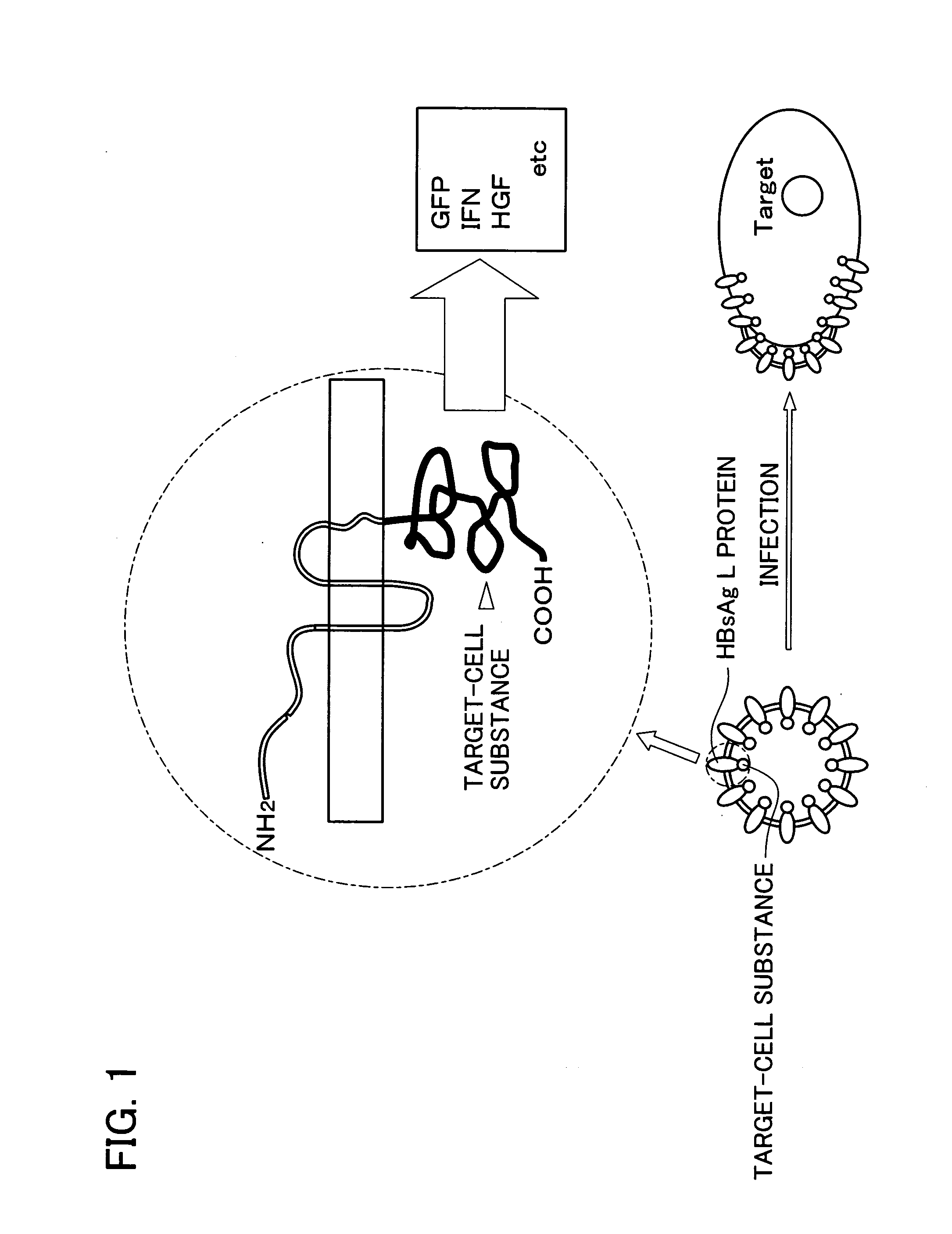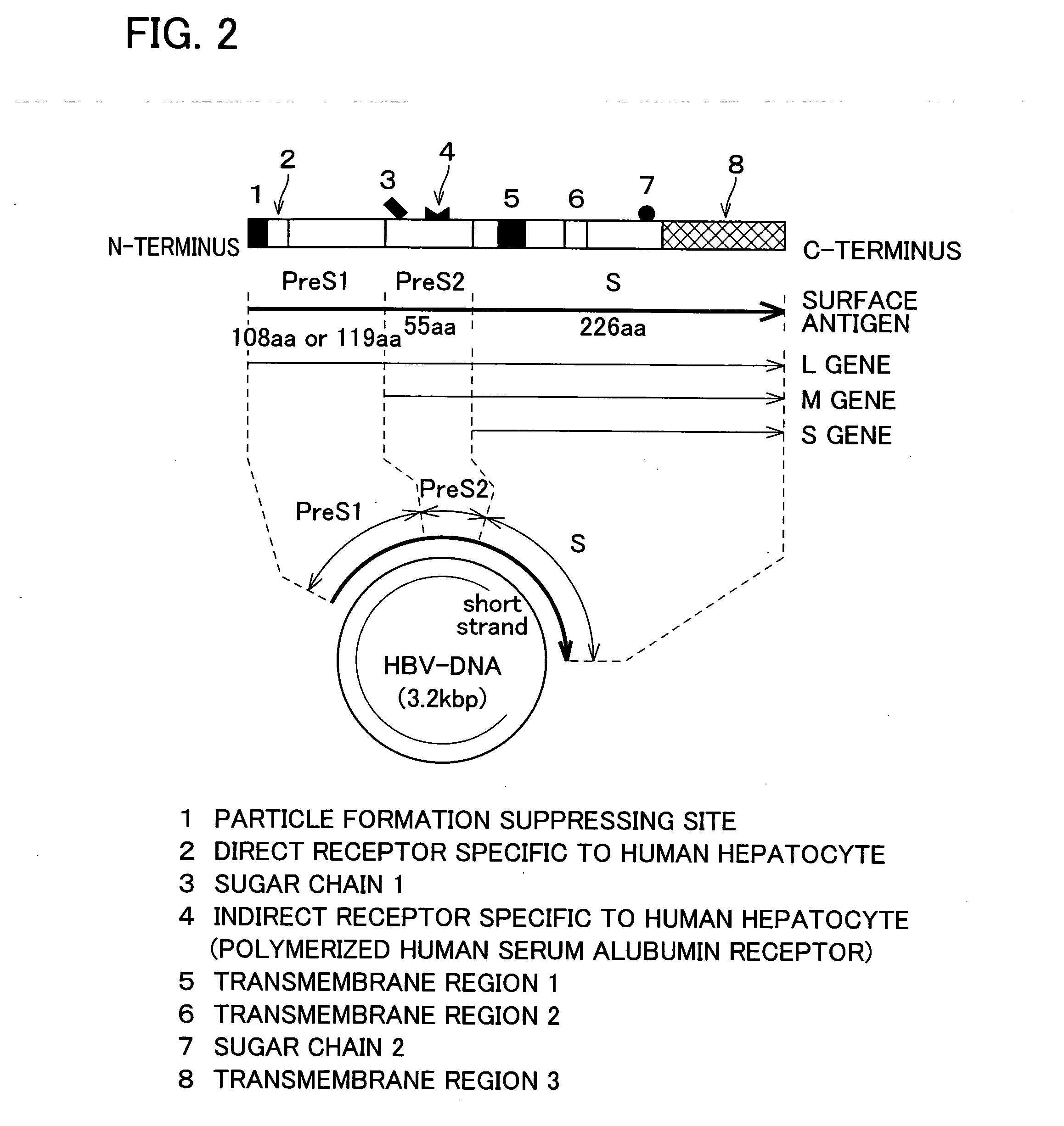Drugs comprising protein forming hollow nanoparticles and therapeutic substance to be transferred into cells fused therewith
- Summary
- Abstract
- Description
- Claims
- Application Information
AI Technical Summary
Benefits of technology
Problems solved by technology
Method used
Image
Examples
examples
[0043] In the following, HBsAg refers to hepatitis B virus surface antigen. HBsAg is an envelope protein of HBV, and includes three kinds of proteins S, M, and L, as schematically illustrated in FIG. 2. S protein is an important envelope protein common to all three kinds of proteins. M protein includes the entire sequence of the S protein with additional 55 amino acids (pre-S2 peptide) at the N-terminus. L protein contains the entire sequence of the M protein with additional 108 amino acids or 119 amino acids (pre-S1 peptide) at the N-terminus.
[0044] The pre-S regions (pre-S1, pre-S2) of HBV have important roles in the binding of HBV to the hepatocytes. The Pre-S1 region has a direct binding site for the hepatocytes, and the pre-S2 region has a polymeric albumin receptor that binds to the hepatocytes via polymeric albumin in the blood.
[0045] Expression of HBsAg in the eukaryotic cell causes the protein to accumulate as membrane protein on the membrane surface of the endoplasmic re...
example a
Expression of HBsAg particles in recombinant yeasts
[0047] Recombinant yeasts (Saccharomyces cerevisiae AH22R-strain) carrying (pGLDLIIP39-RcT) were cultured in synthetic media High-Pi and 8S5N-P400, and HBsAg L protein particles were expressed (FIGS. 3(a) through 3(c)). The whole procedure was performed according to the method described in J. Biol. Chem., Vol. 267, No. 3, 1953-1961, 1992 reported by the inventors of the present invention.
[0048] From the recombinant yeast in stationary growth phase (about 72 hours), the whole cell extract was obtained with the yeast protein extraction reagent (product of Pierce Chemical Co., Ltd.). The sample was then separated by sodium dodecyl sulfate-polyacrylamide gel electrophoresis (SDS-PAGE), and the HBsAg in the sample was identified by silver staining.
[0049] The result showed that HBsAg was a protein with a molecular weight of about 52 kDa.
example b
Purification of HBsAg Particles from the Recombinant Yeasts
[0050] (1) The recombinant yeast (wet weight of 26 g) cultured in synthetic medium 8S5N-P400 was suspended in 100 ml of buffer A (7.5 M urea, 0.1 M sodium phosphate, pH 7.2, 15 mM EDTA, 2 mM PMSF, and 0.1% Tween 80), and disrupted with glass beads by using a BEAD-BEATER. The supernatant was collected by centrifugation (FIGS. 3(c) and 3(d)).
[0051] (2) The supernatant was mixed with a 0.75 volume of PEG 6000 solution (33%, w / w), and cooled on ice for 30 min. The pellets were collected by centrifugation at 7000 rpm for 30 min, and resuspended in buffer A without Tween 80.
[0052] (3) The solution was layered onto a 10-40% CsCl gradient, and ultracentrifuged at 28000 rpm for 16 hours. The centrifuged sample was divided into 12 fractions, and each fraction was tested for the presence of HBsAg by Western blotting (the primary antibody was the anti-HBsAg monoclonal antibody). The HBsAg fractions were dialyzed against buffer A with...
PUM
| Property | Measurement | Unit |
|---|---|---|
| Therapeutic | aaaaa | aaaaa |
Abstract
Description
Claims
Application Information
 Login to View More
Login to View More - R&D
- Intellectual Property
- Life Sciences
- Materials
- Tech Scout
- Unparalleled Data Quality
- Higher Quality Content
- 60% Fewer Hallucinations
Browse by: Latest US Patents, China's latest patents, Technical Efficacy Thesaurus, Application Domain, Technology Topic, Popular Technical Reports.
© 2025 PatSnap. All rights reserved.Legal|Privacy policy|Modern Slavery Act Transparency Statement|Sitemap|About US| Contact US: help@patsnap.com



